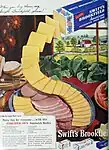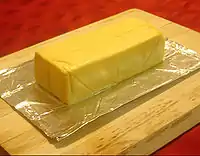Processed cheese
Processed cheese (also known as process cheese, cheese food, prepared cheese, or cheese product) is an ultra-processed food made from cheese and unfermented dairy ingredients mixed with emulsifiers. Additional ingredients, such as vegetable oils, salt, food coloring, or sugar may be included. As a result, many flavors, colors, and textures of processed cheese exist. Processed cheese typically contains around 50 to 60% cheese and 40 to 50% other ingredients.[1][2]

History
Processed cheese was first developed in Switzerland in 1911, when Walter Gerber and Fritz Stettler, seeking a cheese with longer shelf life and influenced by cheese sauces such as those used in fondue, added sodium citrate to melted Emmentaler cheese and found that the emulsified cheese sauce could be re-cooled into a solid again.[3][4] Shortly after, in 1916, Canadian-American businessman James L. Kraft applied for the first U.S. patent covering a new method of processing cheese, which halted the maturation process.[5]
Advantages

Processed cheese has several technical advantages over natural cheese,[6] including a far longer shelf life, resistance to separating when cooked (meltability), and a uniform look and physical behavior. Its mass-produced nature also provides a dramatically lower cost—to producers and consumers alike—than conventional cheesemaking. This, in turn, enables industrial-scale production volumes, lower distribution costs, a steadier supply, and much faster production time compared to traditional cheeses.
The use of emulsifiers in processed cheese results in a product that melts without separating when cooked; with prolonged heating, some traditional cheeses (especially cheddar and mozzarella) separate into a lumpy combination of protein gel and liquid fat. The emulsifiers (typically sodium phosphate, potassium phosphate, tartrate, or citrate) reduce the tendency for tiny fat globules in the cheese to coalesce and pool on the surface.
Because processed cheese does not separate when melted, it is used as an ingredient in a variety of dishes. Unlike some unprocessed cheeses, heating does not alter its taste or texture.
Sale and labeling
Processed cheese is often sold in blocks, pressurized cans, and packs of individual slices, often separated by wax paper, or with each slice individually wrapped by machine.
United Kingdom
In the United Kingdom, processed cheese is typically sold in individually wrapped slices, often referred to as "singles", or in foil-wrapped portions. Dairylea and The Laughing Cow are leading brands.
United States

In 1916, Canadian James L. Kraft applied for the first U.S. patent for a method of making processed cheese.[7][8][9] Kraft Foods Inc. developed the first commercially available, shelf-stable, sliced processed cheese; it was introduced in 1950. The first commercially available individually wrapped cheese slices were introduced in the US by Clearfield Cheese Co. in 1956.[10] These forms of processed cheese have become ubiquitous in U.S. households ever since, most notably used for cheeseburgers and grilled cheese sandwiches because of its ability to cook evenly, distribute/stretch smoothly, and resist congealing, unlike traditional cheddar cheeses. Competitors lobbied unsuccessfully to require processed cheese be labeled "embalmed cheese".[11]
The best known processed cheese in the United States is marketed as American cheese by Kraft Foods, Borden, and other companies. It is yellow or off-white, mild, has a medium consistency and melts easily. It is typically made from a blend of cheeses, most often Colby and cheddar. Another type of processed cheese created in the United States is Provel pizza cheese, which uses cheddar, Swiss, and provolone cheeses as flavorants.[12] Provel cheese is commonly used in St. Louis-style pizza.[13]
Legal definitions
The high proportion of additives in processed cheese (e.g. unfermented dairy products, emulsifiers, oils, salts, and colors) means that some products made in this way cannot legally be labeled as cheese in many countries, even though similar products containing a higher percentage of cheese can be. (However, some manufacturers have found ways to use the word "cheese" on labels even when a product contains too little cheese to meet the minimum standard; see below.) Products that do meet the standards but have a relatively high percentage of additives tend to be classified as "cheese food", "cheese spread", or "cheese product" (depending primarily on the amount of cheese, moisture, and milkfat present in the final product).
United States

Upper left: a "pasteurized process cheese food" and a "pasteurized processed cheese spread"
Upper center: a "pasteurized process cheese spread Havarti-type flavor"
Lowermost right: a "pasteurized process cheese food with jalapeño peppers"
In the United States, processed cheese is defined, categorized, and regulated by the Food and Drug Administration (FDA) under the U.S. Code of Federal Regulations Title 21, Section 133 ("Cheeses and Cheese-Related Products").[14] Pasteurized process cheese can be made from a single cheese, or a blend of several cheeses. Cream, milk fat, water, salt, color, and spices may also be added. The mixture is heated with an emulsifier, poured into a mold, and allowed to cool. The definitions include:
- Pasteurized process cheese, which is made from one or more cheeses (excluding certain cheeses such as cream cheese and cottage cheese, but including American cheese[lower-alpha 1]). In the final product, moisture must not be more than 41 percent of the weight, and fat content not less than 49 percent.
- Pasteurized process cheese food, which is made from one or more of the cheeses available for pasteurized process cheese composing not less than 51 percent of the final weight, mixed with one or more optional dairy ingredients such as fluid milk or whey, and which may contain one or more specified optional non-dairy ingredients. The final solid form must be less than 44 percent moisture and have a fat content greater than 23 percent.
- Pasteurized process cheese spread, which is made similarly to pasteurized process cheese food but must be spreadable at 70 °F (21 °C). Moisture must be between 44 and 60 percent of the total weight, and fat content greater than 20 percent.
The FDA does not maintain a standard of identity for either "pasteurized prepared cheese product", a designation which particularly appears on many Kraft products, or "pasteurized process cheese product", a designation which appears particularly on many American store- and generic-branded singles. Since by using undefined terms the manufacturers technically avoid being accused of false labeling, products carrying such labels are free to use milk protein concentrate (MPC) in their formulations, an ingredient the FDA does not permit in processed cheese. The desire to use inexpensive imported milk protein concentrate to replace some of the cheese in their products is noted as motivation for the manufacturers to introduce these and similar terms, and for the relabeling of some products.[15][16] After an FDA Warning Letter protesting Kraft's use of MPC in late 2002,[17] some varieties of Kraft Singles formerly labeled "pasteurized process cheese food" became "pasteurized prepared cheese product", Velveeta was relabeled from "pasteurized process cheese spread" to "pasteurized prepared cheese product", and Easy Cheese from "pasteurized process cheese spread" to "pasteurized cheese snack".
 A 1948 U.S. advertisement for an American pasteurized cheese food
A 1948 U.S. advertisement for an American pasteurized cheese food.jpg.webp) Easy Cheese, a pasteurized process cheese spread product, on a pretzel[18]
Easy Cheese, a pasteurized process cheese spread product, on a pretzel[18]
See also
Notes
- Under the U.S. Code of Federal Regulations Title 21, Article 133, Section 169 (Pasteurized process cheese), the allowed usage of the term "American Cheese" for certain types of "Pasteurized process cheese" is detailed. Specifically, in paragraph (e)(2)(ii) of section 133.169, it states, "In case it is made of cheddar cheese, washed curd cheese, colby cheese, or granular cheese or any mixture of two or more of these, it may be designated 'Pasteurized process American cheese'; or when cheddar cheese, washed curd cheese, colby cheese, granular cheese, or any mixture of two or more of these is combined with other varieties of cheese in the cheese ingredient, any of such cheeses or such mixture may be designated as 'American cheese'."
References
- Delany, Alex (25 April 2018). "What Is Processed Cheese, and Should We Eat It?". Bon Appetit. Retrieved 26 June 2020.
- Costello, Rose (22 October 2019). "What's really in a packet of processed cheese slices?". Irish Times. Retrieved 26 June 2020.
- Ustunol, Zey (April 2009). "Processed Cheese: What is that Stuff Anyway?" (PDF). Michigan Dairy Review. Michigan State University. 14 (2). Retrieved 4 December 2021.
- Schmelzkäse/ Fromage fondu in the online Culinary Heritage of Switzerland database.
- "Kraft Foods Ltd". Private Revenue Perfins of Victoria. Article includes historical information about a stamp used by Kraft Foods Ltd. in 1932 in Australia. Retrieved 15 January 2021.
{{cite web}}: CS1 maint: others (link) - AP-42, 9.6.1: Natural And Processed Cheese (PDF), US EPA, July 1997
- Kraft, James Lewis, "Process of sterilizing cheese and an improved product produced by such process," U.S. patent no. 1,186,524 (filed: March 25, 1916 ; issued: June 6, 1916).
However, Kraft's process did not include the use of emulsifiers in processed cheese. The first U.S. patent for the use of emulsifiers was awarded in 1921 to George Herbert Garstin:
- Garstin, George Herbert "Cheese and process for sterilizing same," U.S. patent no. 1,368,624 (filed: October 28, 1920 ; issued: February 15, 1921).
- Ustunol, Zey (April 2009). "Processed cheese: What is that stuff anyway?" (PDF). Michigan Dairy Review. 14 (2): 1–4.
- "Emmi Gerber – Über Gerber". Emmi Fondue AG. Archived from the original on 31 May 2013. Retrieved 26 March 2013.
- "Kraft Foods Corporate Timeline" (PDF). Kraft Foods Group, Inc. Archived from the original (PDF) on 3 December 2013. Retrieved 26 March 2013.
- U.S. Patent 2759308 by Arnold Nawrocki was assigned to Clearfield Cheese Co. in 1956.
- "James L. Kraft". www.nndb.com. Retrieved 7 July 2017.
- Hulin, Belinda (2007). The Everything Pizza Cookbook: 300 Crowd-Pleasing Slices of Heaven. F+W Publications, Inc. p. 7. ISBN 978-1-59869-259-4. Retrieved 30 September 2012.
- Barry A. Law; A. Y. Tamime, eds. (24 June 2011). Technology of Cheesemaking. John Wiley & Sons. p. 355. ISBN 978-1-4443-4789-0.
- "21 CFR Part 133 - Cheeses and Related Cheese Products". Code of Federal Regulations.
- "U.S. Imports of Concentrated Milk Proteins: What We Know and Don't Know?", Jesse, Marketing and Policy Briefing Paper No. 80, Department of Agricultural and Applied Economics, College of Agricultural and Life Sciences, University of Wisconsin-Madison Cooperative Extension, University of Wisconsin-Extension, February 2003. Accessed 8 February 2010.
- "What is 'Real Kraft Cheese'?", Chicago Business, 5 February 2007. Accessed 9 February 2010.
- "Warning Letters: Kraft Foods North America, Inc. 18-Dec-02". US Food and Drug Administration. 18 December 2002. Archived from the original on 10 January 2011. Retrieved 7 April 2015.
- Monk, A. (1991). Convenience food facts: help for planning quick, healthy, and convenient meals. Wellness & nutrition library. DCI/Chronimed Pub. p. 98. ISBN 9780937721773. Retrieved 1 June 2017.